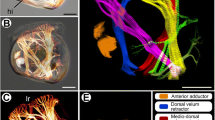Summary
In the m. lateralis of Selachii a well-developed perimysium is found, while a similar structure is lacking in Teleostei. The Selachian perimysial fibres are arranged in distinct planes. In such planes two predominant fibre directions are found; the angle between each of them and the body-axis is 60–70°. Additionally the myosepts contain fibre bundles which are arranged in oblique loops. These myoseptal fibre-loops are present in Squalus, well as in the Teleosts we examined. In order to investigate the functional significance of these fibre arrangements we constructed a model, consisting of a steel strip representing the axial skeleton and a bundle of stretched rubber tubes representing the lateral musculature. Both components of this model have to be firmly interconnected. This is easily achieved by winding oblique loops of cotton thread around them, thus tying them to each other. When we now release the stretched rubber tubes, they contract, resulting in a proper bending of the model. An optimal value for the angle between the body-axis and the direction of the fibres is found.
On the basis of the morphological similarity between the perimysial and the myoseptal loop fibres on the one hand and the cotton thread loops on the other, it is suggested that a functional similarity exists as well. So it is suggested that the functional significance of the perimysial fibre system, and of the myoseptal fibre loops, is the achievement of a firm contact between the lateral muscle mass and the axial skeleton.
Similar content being viewed by others
Literature
Alexander, R. McN.: The orientation of muscle fibres in the myomeres of fishes. J. mar. Ass. U. K. 49, 263–290 (1969).
Gray, J.: Undulatory propulsion. Quart. J. micr. Sci. 94, 551–578 (1953).
Hudson, R. C. L.: Polyneuronal innervation of the fast muscles of the marine Teleost Cottus scorpius L. J. exp. Biol. 50, 47–67 (1969).
Jarman, G. M.: A note on the shape of fish myotomes. Symp. Zool. Soc. 5, 33–35 (1961).
Nursall, J. R.: The lateral musculature and the swimming of fish. Proc. zool. Soc. Lond. 126, 127–143 (1956).
Stelt, A. van der: Muscle mechanics and structure of myotomes of fish [in Dutch]. Diss. Univ. Amsterdam (1968).
Szarski, H.: The function of myomere folding in aquatic Vertebrates. Bull. Acad. pol. Sci. Cl. 2 12, 305–306 (1964).
Weibel, E. R., Elias, H. (eds.): Quantitative methods in morphology. Berlin-Heidelberg-New York: Springer 1967.
Willemse, J. J.: The way in which flexures of the body are caused by muscular contractions. Proc. kon. ned. Akad. Wet. C 62, 589–593 (1959).
Willemse, J. J.: Functional anatomy of the myosepts of fishes. Proc. kon. ned. Akad. Wet. C 69, 58–63 (1966).
Author information
Authors and Affiliations
Rights and permissions
About this article
Cite this article
Willemse, J.J. Arrangement of connective tissue fibres in the musculus lateralis of the spiny dogfish, Squalus acanthias L. (chondrichthyes). Z. Morph. Tiere 72, 231–244 (1972). https://doi.org/10.1007/BF00391553
Received:
Issue Date:
DOI: https://doi.org/10.1007/BF00391553




